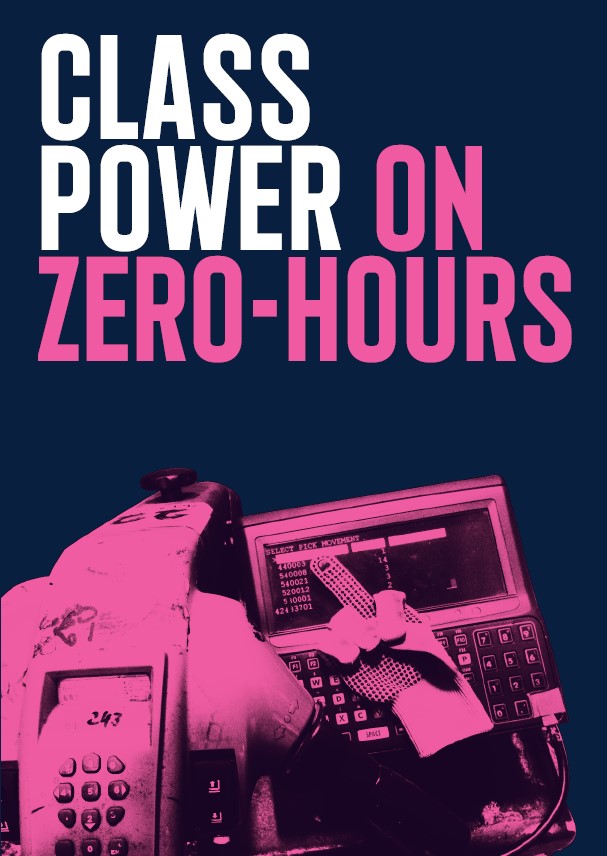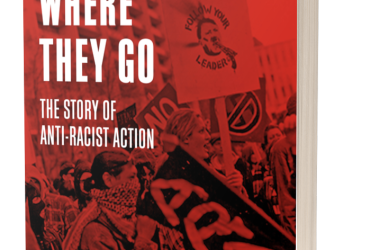By Jarrod Shanahan
Brooklyn Rail
June 2020
AngryWorkers want you to build an international revolutionary
organization guided by the axiom “the emancipation of the working
classes must be conquered by the working classes themselves,” and they
have a plan. Six years ago the communist grouplet relocated from London
to a western industrial suburb called Greenford, where they found a
dizzying array of industrial and logistical facilities central to
keeping Greater London running. Greenford, they discovered, “typified
one of capitalism’s main contradictions: that workers have enormous
potential power as a group, especially if they could affect food supply
into London, at the same time they are individually weak.” AngryWorkers
set up shop and organized tirelessly inside and outside the union
structure in a number of industrial workplaces, in community campaigns
against austerity and their own solidarity network, and through the WorkersWildWest newspaper
which they distribute at factory gates at the crack of dawn. None of
these practices are new, and some may seem better left in the 20th
century. But AngryWorkers’ new book Class Power on Zero-Hours (London:
AngryWorkers, 2020), a sustained reflection on the past six years of
this organizing, reveals their praxis to be even more timely than
authors could have known.
Class Power recounts the group’s organizing experiences and the
lessons they have drawn from them, while underscoring the necessity for
coordinated working-class rebellions throughout global logistical
networks, and the imperative for the UK left to change courses following
the defeat of its social democratic ambitions in the figure of Jeremy
Corbyn. By sheer coincidence the book hits shelves as the COVID-19
crisis has dramatically heightened social dependency on services like
Amazon and Instacart, and thrust logistics workers’ struggles into the
open as increased exploitation and dangerous working conditions add more
fuel to the fire across the supply chain. Simultaneously a new
generation of self-proclaimed socialists in the United States are
reeling from the electoral defeat of Bernie Sanders, just as Corbynites
were as Class Power was headed to press, and vow in great
numbers to exit the US Democratic Party in search of more radical and
unmediated forms of political participation. May this wonderful book
fall into their hands, and those of all searching for direction in a
moment of great transition, when few things are certain beyond the
surety of heated struggles to come.
Getting Rooted
AngryWorkers delight in having found a base of operations of which many
London leftists have never heard, and consistently contrast their
experiences in Greenford with vogue theories of “post-industrial”
societies and “immaterial labor” which thrive among urban
intelligentsia. A far cry from post-industrial, Greenford is
home to a highly-concentrated international proletariat largely hailing
from Africa, South Asia, and Eastern Europe and thrown into fraught
relations of cooperative labor at similarly heterogeneous points of
production. AngryWorkers argue that places like Greenford represent the
return of large concentrations of workers in space, following capital’s
decades-long restructuring of productive relations away from large
centralized factories that could serve as proletarian strongholds.
Accordingly, they argue that Greenford and places like it present
Achilles’s heels of capital in its present composition, begging
concerted communist organizing. One nearby office park, which
AngryWorkers dubs the “crown jewel of a workers’ vanguard,” boasts
40,000 workers laboring in 1,500 businesses ranging food production,
custom printing, tech, transportation, laundry, waste processing,
hospitality, and studio film production, alongside a hospital,
international student housing, a massive supermarket, and all kinds of
cafes and other working-class haunts. “We have to contrast the strategic
joy of engaging with this potential jewel of a working class movement,”
they write, “with the stale and often airy Labour party politics and
internal power-fights that many London lefties prefer to get involved
with. We ask ourselves: what the fuck?!”
The group suggests that anyone can simply walk around a place like
Greenford with their eyes and ears open and learn a lot about the world
they live in. But the treasure trove of thick descriptions and practical
wisdom which fill Class Power’s nearly 400 pages is largely
derived from years of full immersion in Greenford life, and purchased at
great exertion of time and energy of a small group of dedicated
militants. To get rooted in Greenford, AngryWorkers took up in crowded
proletarian neighborhoods, labored for years on end in low-wage
warehouse, factory, and transportation work, and merged their social
lives with the dense local networks that crisscross thousands of shops
drawing on temp workers, zero-hour (no work guaranteed) contracts, and
other ingredients for high turnover. “You can do a lot more than you
think,” they remark, “when your ‘political life’ and ‘normal life’ isn’t
so divided.”
Getting to Work
“As an organization we take on a responsibility,” they write. “The
responsibility to help turn the global cooperation of workers, which is
mediated through corporations and the markets, into their own tool of
international struggle.” While the group scorns programmatism, their
model is tripartite, combining intensive workplace organizing,
solidarity networks and other community engagement, and regular
distribution of print propaganda whichcollects grievances and
other seeds of potential workplace campaigns, reports on strikes in
similar workplaces or nodes on the same supply chain, and conditions of
daily life outside the factory. This final item has provided much of the
raw material for Class Power, and demonstrates laudable
efforts to move beyond the same old jargon and sloganeering and write
for an audience far removed from the Facebook International. Above all,
the honesty and self-critical stance from which they evaluate their
organizing provides a wealth of practical reflection for organizers in a
variety of settings.
For starters, AngryWorkers intend the solidarity network model to ground
them in Greenford’s proletarian life and begin to tap the networks that
traverse workplaces and neighborhoods. Class Power recounts a
number of these campaigns, introducing the reader to Senegalese kitchen
workers, Bulgarian apple pickers, Moroccan factory works, Somali bus
depot cleaners, Punjabi truck drivers and construction workers,
Sundanese hotel workers, and Polish tenants, united by their common
status as highly exploited laborers and tenants, often victimized by
more affluent and better-rooted members of their own “communities.” As a
kind of organizing first principle, they opt to avoid a formal
organizational name or “brand” identity, concerned that a clear
organizational identity could become a fetish object, obscuring from its
participants the material reality that their collective activity
constitutes the group’s power.
The group narrates its initial trouble getting over the hump of making
contacts. Film screenings and open hours at community centers fail to
attract workers, they change tacks and set up at working-class cafes,
including a McDonald’s. This pivot attracts far more interested workers,
who bring with them rich social networks traversing the region, replete
with experiences of exploitation upon which campaigns could be built.
Predictably enough the solidarity network runs into problems typical of
the model, namely their inability to transcend the “service” model which
nonprofits and social workers have conditioned working people to expect
in place of direct-action and empowerment. They also have trouble
getting workers to stick around after their campaign has been won.
Nonetheless, they rack up back wages to the tune of £25,000, and along
with local efforts against library closures and the demolition of a
working-class community center, demonstrate in practice the remarkable
heterogeneity of Greenford’s proletariat and the invisible lines of
interconnectivity that run throughout neighborhoods and workplaces. In
their critical reflections, they wonder if a more formal structure would
have proven more effective and sustained better over time. It is an
open question with the solidarity network and all of the AngryWorkers
projects, and it is a question that can only be addressed in practice.
The centerpiece of their strategy is workplace organizing, which lands
AngryWorkers comrades in refrigerated warehouses, prepared food assembly
lines, labyrinthine distribution centers, auto transportation across
the so-called “last mile” between warehouse and the consumer’s home, and
even a shop manufacturing 3D printers, which they discover to be a full
180 degrees away from the feel-good techno-utopianism of “open source”
ideology. Their guiding praxis seeks to identify and encourage worker
militancy, rather than recruit people to a group or a particular
political standpoint. Once a comrade has taken root in a shop, they
begin to identify grievances and potential seeds of struggle. While this
comrade plays it tight to the vest, slowly building the trust of
workers and not making their politics known, comrades on the outside
distribute literature outside the shop, and stories from these various
workplaces appear in WorkersWildWest.
All the while, the comrades on the inside toil under arduous, bleak (a recurring adjective in Class Power),
and near-dystopian conditions. They take months and even years to build
the basis for a single campaign, all the while engaged in punishing
daily regiments. In the refrigerated “chill” warehouse, for instance,
the comrade stuck in there all day must sort boxes and trays of food at a
fast pace, with their forearm adorned with a computer console that
gives orders and connects to a finger-mounted scanner monitoring
productivity! If they sink below the required pace, they receive a text
message warning, followed by loss of work. All this, on temp wages. When
they are finally fired for organizing a slowdown, after the better part
of a year in these conditions, they don’t seem too sad to go.
Tellingly, the biggest obstacle facing their organizing efforts was the
high turnover, and the propensity of the ablest would-be militants to
simply quit in search of better conditions and pay instead of working
long-term to build worker power in the shop. And who can blame them?
In this work AngryWorkers draws inspiration from the present syndicalism
renaissance, in particular the organizing of Italy’s SI Cobas,1
militant unionists in the logistics sector whose actions AngryWorkers
publicize in their factory newspaper as potential inspiration for
English workers. They are appreciative but more critical of the en vogue approach championed by labor expert Jane McAlevey, author of No Shortcuts (Oxford
University Press, 2016), who they argue correctly points for a need to
break with top-down “service unionism,” but does not sufficiently break
from the binary—and often hierarchy—of “organizer” and “worker” inherent
to professional labor organizing. By contrast, the AngryWorkers call
quite rightly for the abolition of waged union jobs and professional
organizing altogether. At the same time, they draw influence from “class
unions” like the IWW, who they partner with in a number of campaigns,
but question the use of conflating unions with broader political organs
of a working-class offensive.
Above all, their calculus of workplace strategy is guided by an aversion
to allowing unions, or any organization, to become a fetish object
standing above the power that working people wield when they take action
in concert. These motives are understandable to any critically-minded
person who has engaged with a contemporary labor union and suffered its
vapid sloganeering, quasi-military hierarchy, and mystification of “the
union” as greater than the struggles of its members—all while leadership
acts as the left wing of management, enriching itself and perhaps a
tier of the highest-waged workers at the expense of everybody else. Yet
it is perhaps the greatest strength of the AngryWorkers’ praxis that
they do not merely abstain from union participation on principle, but
experiment with the union itself as a potential site of struggle.
As astute observers of contemporary capitalism, AngryWorkers believe
unions “essentially exist to manage the relationship between labor and
capital rather than overcome it,” as one member working at a food
production facility writes. “But rather than rely on left-communist
dogma,” they continue, “we wanted practical experience within the big
unions to see how things actually operated.” Thus begins a multi-year
experiment working as a rep in a rotten company union which scarcely
masks its pact with management against the workers. Taken in sum the
worker-cum-rep’s experiences surely do not contradict “left-communist
dogma” about the structural role of unions in capitalist society.
Simultaneously, however, they provide a nuanced account of how union
offices can be used as a strategic point of leverage for building
extra-union worker power.
For instance, under the cover afforded by the union rep position, this
worker was able to openly collect and socialize grievances, distribute
literature, network with more militant workers, and help organize a
number of protests demanding pay increases—all to the chagrin of the
union and its partners in management, who aren’t immediately able to
clamp down. Similar conclusions are drawn from another comrade’s account
of working as a rep in “last mile” delivery, who concedes the decision
to give union office a whirl arose in part when “our efforts to create
independent structures didn’t go too far.” Far be it from me to ever
endorse the star-crossed endeavor of “union reform,” but these accounts,
far too detailed to do any justice here, provide valuable reflections
for workers in a unionized shop wondering where they can find the best
possible leverage. Like all questions addressed by the AngryWorkers
praxis, the answer is not an easy one.
Getting Acquainted
In the course of their struggles AngryWorkers have produced an immense
body of writing for the purposes of agitation, debate, and to deepen
their own understanding of the complex social world in which they are
taking action. The best of it recalls Engels’s The Condition of the Working Class in England
or the propaganda tracts by the enigmatic writer and illustrator known
only as Prole. In contrast to the odd journalist or photographer who
slums it for a short stint to document the lives of poor downtrodden
workers, AngryWorkers are attentive not just to the obvious deprivation
but to the potential power workers wield in daily cooperation and
resistance. And in contrast to the sectarian, they are not simply
looking for recruits, or to “colonize the factory” as many New Left
groups attempted in the 1970s. They seek instead to identify working
class initiative where it already exists and help generalize it across
shops, supply chains, and entire regions. Thus when they engage with the
contradictions of working-class life which emerge from divisions of
productive and reproductive labor riven by race, gender, ethnicity,
citizenship, language, and other factors, it is with a view to how these
real differences can be overcome to constitute the class as a fighting
force.
In two particularly profound lines of inquiry, originally composed for their propaganda and excerpted in Class Power,
AngryWorkers examine “the crisis of the working-class family” and the
particularity of women’s experiences in the gendered division of factory
labor and bearing the brunt of austerity at home. Lengthy testimonials
from three women speak to a diversity of backgrounds—the young Hungarian
woman who seeks above all freedom from her hometown, the Irish mother
who struggles to balance the impossible calculus of work and care for
her autistic son, the Punjabi mother of two who lives precariously from
visa to visa and has not seen one of her daughters in six years—grounded
at once in a common condition of hyper-exploited labor. As bourgeois
feminism enjoys its day in the sun, these working women’s voices
demonstrate at once the complexity and necessity of approaching gender
analysis from a perspective grounded in the work and home lives of
working-class women. This method, AngryWorkers clearly state, is
distinct from considering “class” as one particular form of
“intersecting” modalities of oppression. Class, instead, is the basis of
exploitation, and the very real and often devastating particularities
of exploitation along lines of race, gender, citizenship, and so forth
are, to pluralize a famous dictum from Stuart Hall, “modalities in which
class is lived.”
These stories and other investigations AngryWorkers undertake paint a
complex and visceral portrait of gender and working-class family life as
immiserated by crushing austerity while rendered evermore necessary by a
deepening harshness of life outside. An inquiry entitled “The Crisis of
the Working-Class Family” builds on their analyses of gender and
workers’ living arrangements to explore the family as a stopgap for the
near-impossibility of survival on working-class salaries. The
working-class family, they argue, is largely a necessity arising from
the impossibility of being alone, and is accordingly packed into
whatever tight living quarters workers can muster, which is often
collective living with extended family or workmates, where the specter
of the exploitative sub-landlord is never far. Simultaneously they argue
that the heterosexual couple, defined by the desperate need to keep
“romantic love” afloat, has become the sole outlet of emotional
expression in search of rich expression, especially for men. The
combination of these elements, they argue, renders working-class
families combustible compounds defined by frustration, desperation, and
strife, which episodically erupt into violence, most often men against
women. While it is difficult to read these passages without feeling
claustrophobic, it is simultaneously powerful to read the concepts of
social reproduction, gender, and the family analyzed through the lives
of real working-class people and in relation to their raison d’etre,
surplus value production.
Another welcome intervention comes around the question of automation and
its relationship to low-waged work. “The whole spiel about ‘full
automation’ is bollocks,” they write in a discussion of the
labor-intensive “chill” warehouse. “Here we are, using thousand-year-old
technology…wheels!…to help us do the bulk of the work, while being
controlled by 21st century high-tech. We are cheap, so why replace us
with robots, which would have difficulty fitting the big banana boxes
into the small cages anyway?” This example is a common theme throughout
the book, as high-tech enables companies to juxtapose automation
technology with disposable low-wage workers, whose resiliency and low
cost or commitment make them a cheaper option than full automation.
Importantly, the onus of discipline still rests on the human element. In
the same passage, they continue:
But low-tech also means that the command of work is not transmitted through a big technical apparatus, which we might hate but at the same time admire and accept. Instead, the command of capital is primarily transmitted through the strained vocal cords of the dumpy managers, who stand and scream at the end of each line: ‘Andranik, stop talking to Preeti, get a move on!’
Elsewhere, they include a photograph of three workers struggling against
a giant crate, with the caption: “Who needs a forklift when you have
three men to move a ton of cabbage?”
As a textual whole, Class Power calls to mind the eccentric genius which strikes the first-time reader of Capital, and while lacking the lengthy mathematical interludes, Class Power
compensates with extensive histories of supermarkets, food
distribution, and West London itself, interspersed with hundreds of
pages of workplace writing at once baroque and immanently practical. The
characters who emerge are complex yet immediately recognizable—the
pissed off temps whose excessive drinking sends an organizing meeting
off the rails, immigrant workers who vote for Brexit to flip the middle
finger to the status quo, the self-styled “rebels” who chicken out when
the time comes to take risks, and perhaps above all, the authors
themselves. The book’s authorial voice episodically changes from plural
to singular as individual yet unnamed and ill-defined workers step forth
to recount their particular experiences before once more dissolving
back into a faceless we. All the while the text preserves a loose sense
of narrative style and a breezy, bathetic, shit-talking sensibility
which makes the collective author the kind of person the reader would
want to have a beer with and maybe listen to a multi-century history of
capitalist agriculture in the process.
Getting Together
By way of a conclusion, AngryWorkers provides something rare among
groups who do not simply reproduce the received texts of the 20th
century: a clear account of how their daily activity connects with the
global communist revolution. “There is no lack of revolutionary anger,”
they write. “What we haven’t seen is a section of the working class that
focuses on the real centres of power—the grain baskets, manufacturing
centres, ports, power plants—with the aim and a plan to take them over.
It might take a few more waves of struggle for such an organized force
to emerge,” they write, but insist nonetheless on the guiding question:
“So what are the bare necessities during a revolutionary transition?”
What follows is a detailed account of how strategic working-class
takeovers throughout the social division of labor could simultaneously
build revolutionary momentum and ward off counterrevolution or
stagnation, the latter most likely to arise from hunger caused by
interruptions of food from the countryside and abroad. “The
communisation-fun,” they tease, “might last three days max before you
start getting hungry.” Here the true prize of their years in Greenford
reveals itself: a practical and strategic understanding of the social
division of labor necessary to reproduce the infrastructure of an area
as complex as Greater London, an understanding which can serve as the
basis for theorizing a revolutionary offensive.
This is not to say that their plan—or anybody’s plan—could be followed
to the letter in a moment of revolutionary transformation. Nor do they
intend this text to be treated in the manner of those who still thump
the Transitional Program onto the table as it approaches its
centennial. Instead, rooted in their own practical-critical
investigations into current compositions of class and capital, they have
created an arc which few of us dare to consider in conversation, much
less commit to publication, between the challenges facing small bands of
organizers attempting to get a toe-hold in strategic centers of
production and circulation, and the bare requirements of going all the
way. It is a perspective far removed from fighting injustice, sticking
up for the powerless, speaking truth to power, purifying oneself from
the evils of capitalism, and inching toward a vanishing horizon of
socialism through piecemeal electoral gains. Instead, it poses a simple
question: how do we build the power it will take to win?
Class Power on Zero-Hours is not without its shortcomings, but
like all great works, its weaknesses are simply the underside of its
strengths. For instance, in their practical analysis of the local
working class, AngryWorkers return time and again to the abstraction of
“the community,” meaning cross-class networks bounded by common
language, nationality, and faith. They correctly argue that these
communities are led by petty bourgeois “leaders” whose
interests—expressed in exploitative employment, housing rental,
citizenship schemes, for-profit language classes, and so forth—are
opposed to the interests of their “community’s” working people. The
AngryWorkers theorize this relation as a basis not only for exploitation
in the present but for authoritarianism in the future, an idea borne
out in their workplace organizing and solidarity networks, where they
encounter coercive “community” relations that prevent workers from
standing up to their bosses and landlords. They have therefore
identified a central contradiction facing the contemporary revolutionary
left, and one which runs many organizers’ revolutionary praxis aground,
as they embrace the abstraction of “community” and thereby lend their
support to cross-class alliances which lead nowhere.
Unfortunately, in formulating this practical analysis, AngryWorkers do
not take seriously enough the powerful objective forces which give these
community leaders their strength. When workers complain of racism in
the factory, the group is quick to offer alternative explanations more
directly tied to the shop’s division of labor. While AngryWorkers do not
dispute the reality of racism and xenophobia, and document extensively
the sick mischief such chauvinism causes among the working-class, they
appear to not consider the color line itself a worthy basis of struggle.
This is doubly frustrating as their own theory, expressed by their
masterful critique of social democracy, decries placing the abstraction
of formal “unity” ahead of unity produced by taking contradictions like
the color line head-on. The group’s aversion to advancing race or
nationality as the basis of struggle is understandable given how
decoupled the two have become in middle-class left analysis. But the
fact that “anti-racism” has become a lucrative industry for building
university and non-profit careers that don’t challenge capital in the
slightest, makes it all the more necessary to carve out a strategic,
working-class anti-racism that takes the color line head-on in pursuit
of the strategic lines AngryWorkers draw so deftly.
A more obvious criticism, which surely dawns on the authors, is that
their individual campaigns have largely come to naught, especially
weighed against the group’s cyclopean labors. Over the years their small
core has attracted a rotating lineup of comrades from across Europe and
even South Asia, but the arduous work and scant unambiguous victories
seem to have made retention in their Greenford cadre about as difficult
as at the local factories themselves. One chapter, recounting an arduous
multi-year organizing effort, concludes: “Things didn’t work out this
time, but that’s the class struggle folks! Better luck next time!” As
this sentiment recurs in various forms throughout their innumerable
efforts, the reader gets the sense that the core comrades are possessed
of a certain disposition which makes them as suitable for this work as
they are rare among the contemporary revolutionary left. Unfortunately,
“better luck next time!” might be enough for a core of stone militants,
but the breakneck pace and dizzying array of campaigns which this small
group took on in a short time seems like a recipe for burnout,
especially absent the galvanizing effect of tangible wins.
Similarly, it is both a strength and a weakness of AngryWorkers that
they attribute their failures thus far to a lack of capacity or
unfortunate turns of events. Ultimately their scrupulously detailed
critical reflections are less concerned with why things didn’t work and
more occupied with how they could have gone differently. This is a sign
at once of great optimism of the will, and also perhaps of a dose of
stubbornness. To these critiques, I’m sure, the authors will reply: all
of this is true, and that’s why you should join us to effect the shift
from quantity to quality!
Accordingly, Class Power concludes with an invitation to
comrades around the world—any town where there are at least two—to begin
practical-critical investigations of nearby workplaces and
infrastructure strategic to working-class insurrection, take up
occupations there whenever possible, build solidarity networks, and to
generalize this practical-critical work with the similar efforts of
groups all over the world. Not all readers (present company included!)
will be willing to cast aside whatever they’re doing and take up
employment at physically punishing low-waged labor in these strategic
sites. But some will, and the AngryWorkers are clear that important work
remains outside the workplace, to agitate, organize in solidarity
networks, support the comrades inside, and help build more generalized
networks of shared practical knowledge. To this effect, the group has
been organizing video conferences, necessitated in part by COVID-19
quarantine, and has continued a dizzying output on their website.2
They are offering literature and flyer templates and practical advice
to anyone seeking to pick up the torch in their own town. If you are on
the fence, don’t take my word for it—reach out to them!
Class Power on Zero-Hours is a difficult book to review, given
its immense wealth of practical information and its scrupulous
recounting of the high price its authors paid to earn it. Moreover, Class Power
is simply a multiplicity of books—not just in its immense length, but
in the rich variety of its content. What might be a throwaway paragraph
to one reader might grab someone with experience in commercial trucking
as the most poetic and damning description of their lives they have ever
read. Same for exploited tenants, women harassed by their bosses,
perennially stymied workplace militants, migrant workers anxious about
the ascendant right, and so forth. It will be a different book to
practically every reader, and will engender vibrant discussion that
grounds strategic horizons in the lived experiences of working-class
people. Accordingly, this reviewer strongly suggests the formation of
study groups wherever possible, among workers already struggling around
the COVID-19 crisis (wherever their time allows), organizers who find
their terrain of struggle turned upside down, and everyone wondering how
best to join the fight. “It can sometimes be frustrating and depressing
when you’re on the front lines of the class war,” the AngryWorkers
conclude, “but on the whole, it’s exhilarating and purposeful and gives
us the means to live how we want.”
-
For English writing by and about SI Cobas, visit https://libcom.org/tags/si-cobas.
- Angry Workers of the World: Precarious and Unruly, https://angryworkersworld.wordpress.com.







